Welcome to our world of creativity and craftsmanship! If you’re looking for a fun and free crochet pattern to make an adorable Amigurumi snail named Rita, you’ve come to the right place. Whether you’re a seasoned crocheter or just starting your crochet journey, this pattern is perfect for you.
Amigurumi Snail Rita Free Pattern is designed with love and care, and it’s a fantastic project for both children and adults. Rita is not your ordinary snail; she’s a cute and huggable companion that you can craft with your own hands.
Now, let’s dive into the world of Amigurumi and create a snail friend that will bring joy to your life. Below, you’ll find detailed instructions and tips to make your crochet adventure as enjoyable as possible. So grab your crochet hook and yarn, and let’s get started on this wonderful journey of creativity!
Materials needed:
“Lacy” from Pekhorka, color No483 – “Unripe Lemon,” 280m/50g, composition: 100% PAN (acrylic). Any thin acrylic or cotton yarn of a delicate greenish shade will work.
“Lacy” from Pekhorka, color No283 – “Salmon,” 280m/50g, composition: 100% PAN (acrylic). Any thin acrylic or cotton yarn of a delicate pink color, of the same thickness as the previous color, will work.
“Lacy” from Pekhorka, color No165 – “Dark Beige,” 280m/50g, composition: 100% PAN (acrylic). Any thin acrylic or cotton yarn in a brownish shade, of the same thickness as the previous colors, will work.
Iris “VITA cotton” in light pink or any thin yarn of this color. Just a tiny bit for the cheeks.
Iris “VITA cotton” in red or any thin yarn of this color, embroidery floss is also acceptable. Just a small amount for mouth embroidery.
White and light green felt for eyes and eyelids. You can also crochet eyes with thin yarn in similar colors.
A piece of wide lace (3 cm in width and approximately 30 cm in length).
Thin wire (no thicker than d=2 mm), about 20 cm.
Polyester stuffing.
Crochet hook No1.
Toy eyelashes.
Quick-drying instant adhesive like “Moment.”
Decorative flowers (optional).
Acrylic fabric paint “Textile Contour” in purple or any other color for decorating the pot (optional).
Abbreviations:
MR – magic ring (amigurumi ring)
ch – chain
sl st – slip stitch
sc – single crochet
sc2tog – single crochet two together (decrease)
inc – increase: two single crochets in one stitch
When using the same yarn as in the tutorial – 14 cm (5.5 inches).
Difficulty Level:
Intermediate
!!!ATTENTION!!!
This master class is intended solely for your personal use!
Reproduction and distribution of these crochet instructions is prohibited.
Selling and displaying the finished product is allowed with an active link to my store:
Please don’t forget to mention: “Author: Taisiya Gertner.”
Thank you for your understanding and respect for my work!
HAPPY CROCHETING!
PATTERN
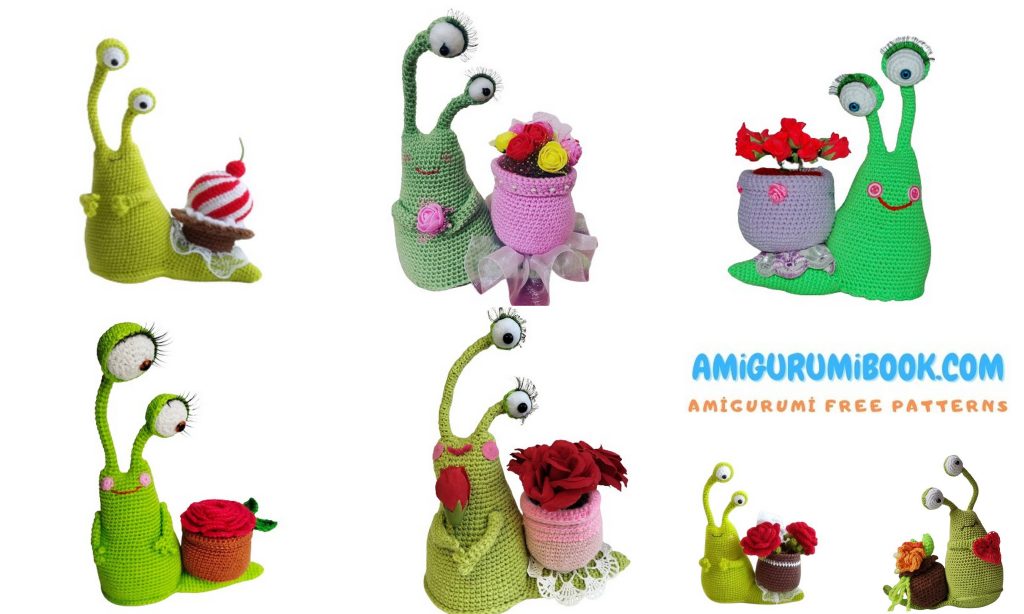
Body:
Let’s start by crocheting the horns. There will be two: short and long.
Short horn (using the light green main color):
Row 1: 6 sc in MR (6)
Row 2: 6 sc in the back loops of the stitches (6)
Rows 3-10: 6 sc – 8 rows (6)
Row 11: 6 inc (12)
Fasten off and cut the yarn.
Long horn (using the light green main color):
Rows 1 and 2 are the same as for the short horn. Then:
Rows 3-22: 6 sc – 20 rows (6)
Row 23: 6 inc (12)
Now, let’s connect the two horns as follows:
Row 24: 1 sc, 2 ch, 1 sc in any stitch of the short horn, 11 sc along it, 2 sc in the front loops of the chain, 11 sc along the long horn (28)
Row 25: 28 sc (28)
Row 26: (6 sc, 1 inc) * 4 (32)
Rows 27-28: 32 sc – 2 rows (32)
Row 29: (7 sc, 1 inc) * 4 (36)
Rows 30-32: 36 sc – 3 rows (36)
Row 33: (8 sc, 1 inc) * 4 (40)
Rows 34-36: 40 sc – 3 rows (40)
Row 37: (9 sc, 1 inc) * 4 (44)
Rows 38-39: 44 sc – 2 rows (44)
Row 40: (10 sc, 1 inc) * 4 (48)
Row 41: 48 sc (48)
Row 42: (7 sc, 1 inc) * 6 (54)
Row 43: 54 sc (54)
Row 44: (8 sc, 1 inc) * 6 (60)
Rows 45-46: 60 sc – 2 rows (60)
Row 47: 4 sc, 1 inc, (9 sc, 1 inc) * 5, 5 sc (66)
Rows 48-57: 66 sc – 10 rows (66)
Row 58: Incomplete row: 16 sc, point A. Fasten off and cut the yarn.
Count 16 stitches from the last sc and insert a marker into the 17th stitch – point B.
Now, insert wire into the horns. Measure about 10 cm of wire, bend the ends, and insert them into the horns, bending them as shown in the picture. Stuff the body.
Next, crochet the bottom of Rita’s snail’s body.



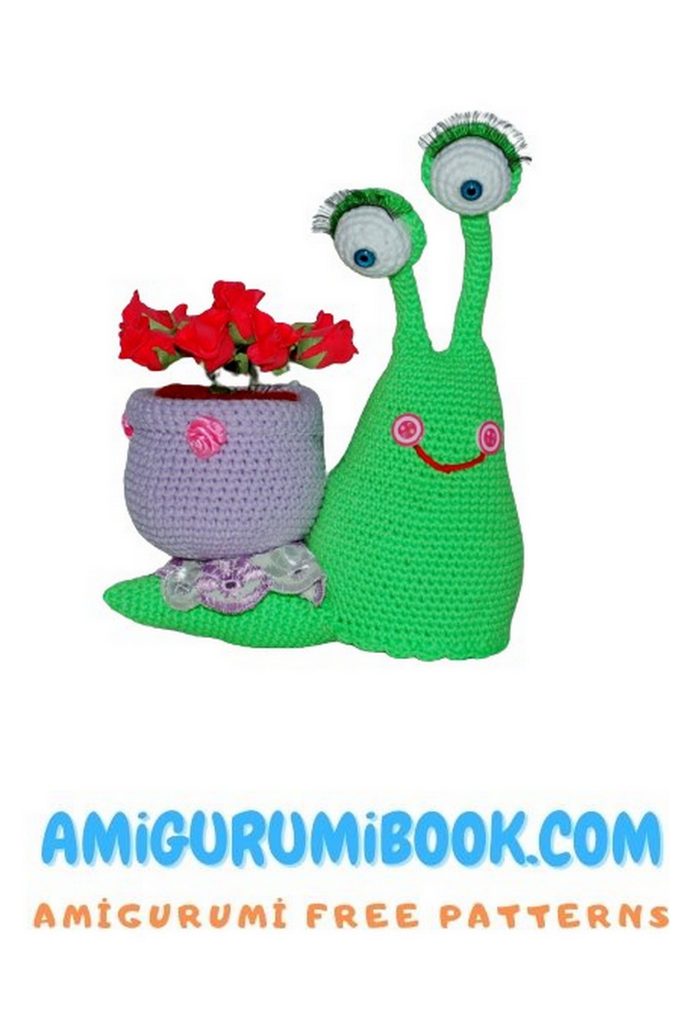
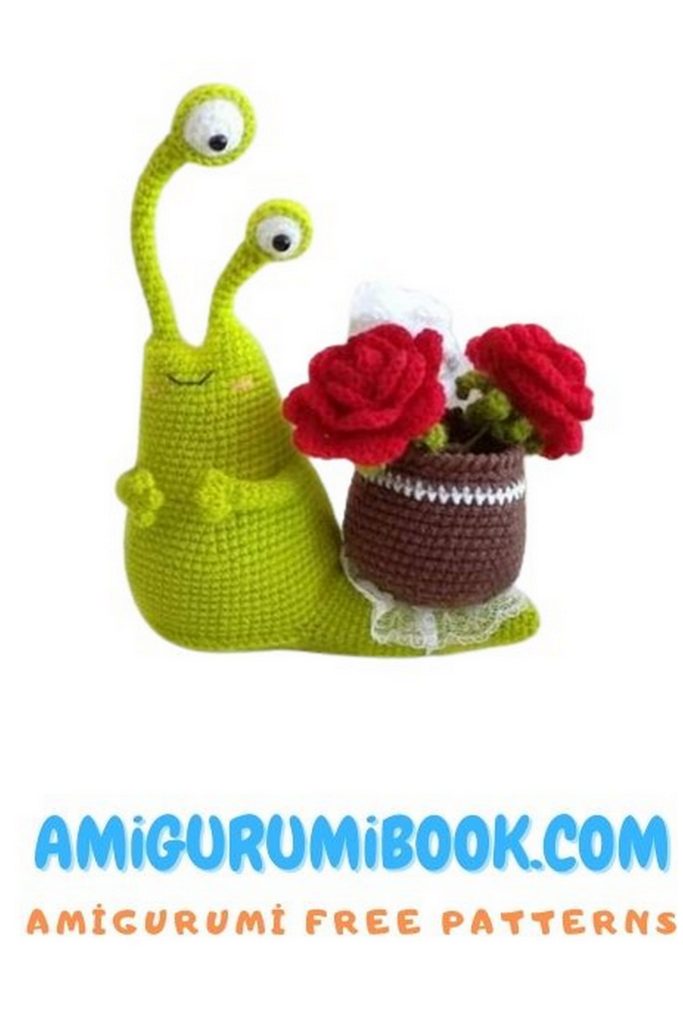
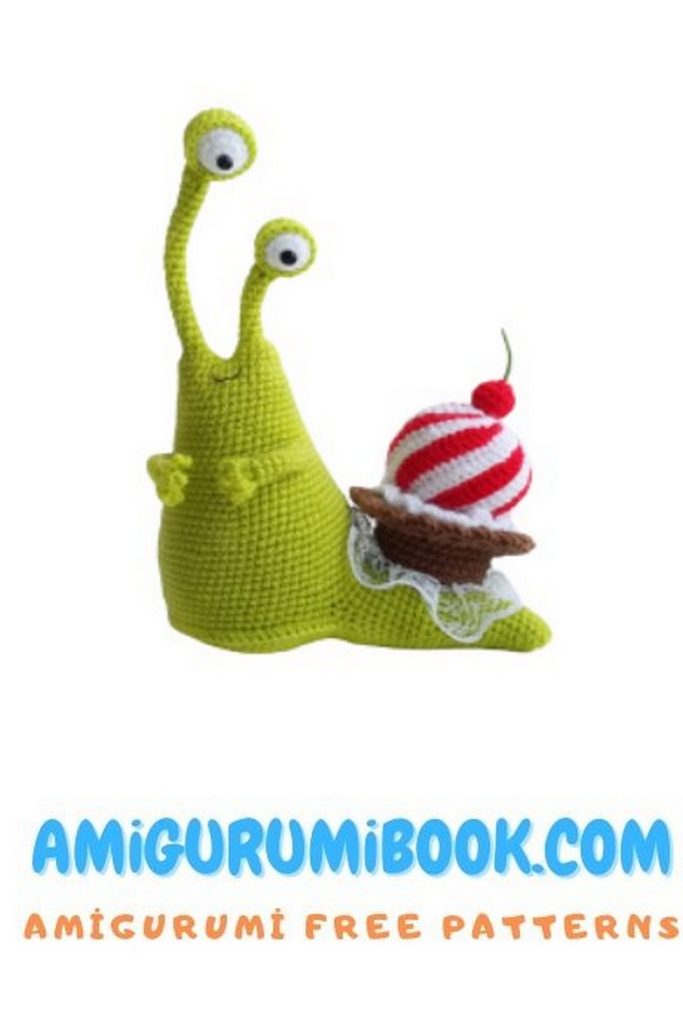
Bottom (using the light green color):
Row 1: 6 sc in MR (6)
Row 2: 6 inc (12)
Row 3: (1 sc, 1 inc) * 6 (18)
Row 4: (2 sc, 1 inc) * 6 (24)
Row 5: 1 sc, 1 inc, (3 sc, 1 inc) * 5, 2 sc (30)
Row 6: (4 sc, 1 inc) * 6 (36)
Row 7: 2 sc, 1 inc, (5 sc, 1 inc) * 5, 3 sc (42)
Row 8: (6 sc, 1 inc) * 6 (48)
Row 9: 3 sc, 1 inc, (7 sc, 1 inc) * 5, 4 sc (54)
Row 10: (8 sc, 1 inc) * 6 (60)
Row 11: 4 sc, 1 inc, (9 sc, 1 inc) * 5, 5 sc (66)
The bottom is ready! To keep the bottom flat, you can cut a circle from plastic or thick cardboard slightly smaller than the crocheted circle, so the toy will be more stable. Attach it using glue and continue crocheting.
12th row: Join the bottom to the body, starting from the marked stitch (point B) and ending at the last stitch in the 58th row (point A). Crocheting goes counterclockwise, and the bottom crochet will go in the opposite direction (50 stitches).
Attention! Make sure the tail is on the side, not at the back!
Next, crochet the snail’s tail (in the round):
13th row: 16 sc along the upper edge (on the body), 16 sc along the lower edge (on the bottom) (32)
14th – 22nd rows: 32 sc – 9 rows (32)
23rd row: (6 sc, 1 sc2tog)*4 (28)
24th row: 28 sc (28)
25th row: (5 sc, 1 sc2tog)*4 (24)
26th – 28th rows: 24 sc – 3 rows (24)
29th row: (4 sc, 1 sc2tog)*4 (20)
30th row: 20 sc (20)
Start stuffing and continue to add stuffing evenly as you go along.
31st row: (3 sc, 1 sc2tog)*4 (16)
32nd – 34th rows: 16 sc – 3 rows (16)
35th row: (2 sc, 1 sc2tog)*4 (12)
36th row: 12 sc (12)
37th row: 6 sc2tog (6)
Close the opening, secure the yarn, cut it, and hide it.
Now, let’s work on the eyes. Take white and light green felt. Cut two circles of different diameters from the white felt: 3 cm and 4 cm.
Use regular sewing thread and a needle to make a running stitch around the edges of the circles, and then gather them, adding some stuffing in the center. Secure the thread and cut it.
Now, cut eyelids from green felt for each of the eyes, roughly this size:
Sew the eyelids to the white eye pieces and glue eyelashes onto them:
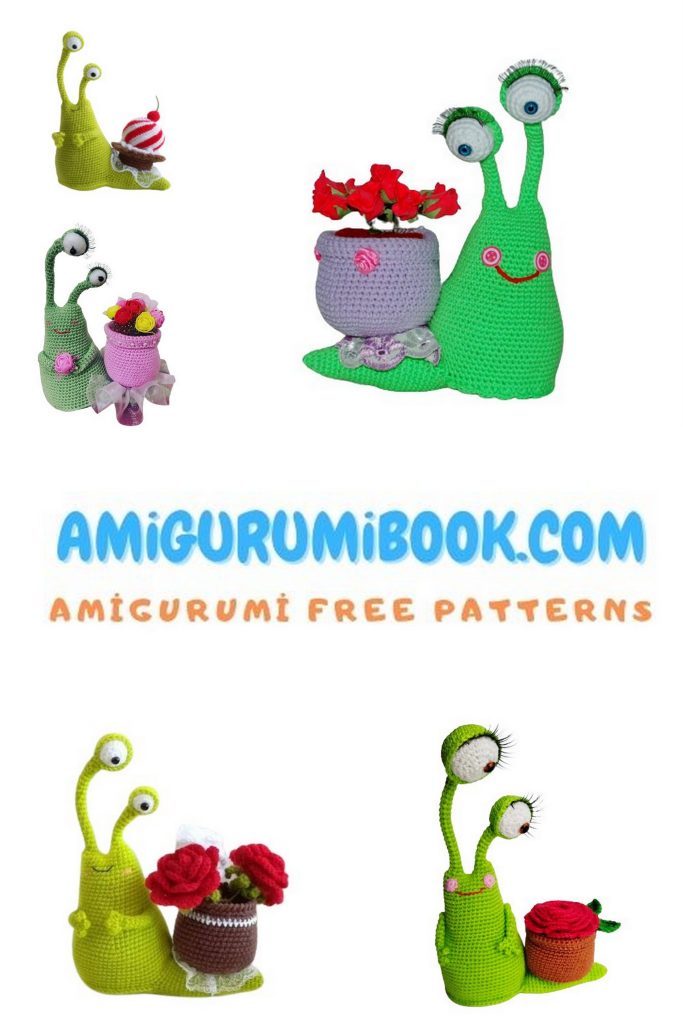
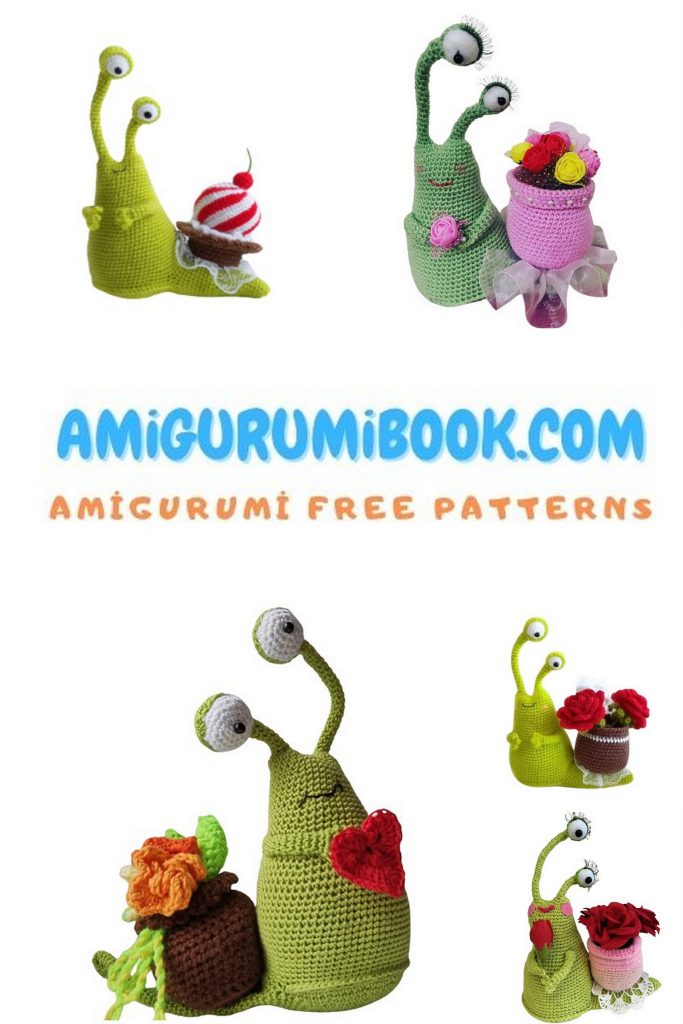
Now, let’s crochet the cheeks (in light pink):
1st row: 6 sc in MR (6)
Cut the yarn, fasten it off.
Embroider the mouth with red thread. Mark the outline of the mouth with pins and start embroidering it with a backstitch.
To give the mouth a smoother look, insert the needle from underneath the first stitch, pull it through, and then insert it under the second stitch in the same way. Do the same with the third stitch:
Now, let’s make the arms:
Crochet them with the light green main color.
1st row: 6 sc in MR (6)
2nd – 8th rows: 6 sc – 7 rows (6)
Cut approximately 12 cm of wire and insert it into the arm. Bend the tip of the wire:
Fold the work so the tube becomes flat and crochet the edges with 3 sc.
Next, crochet the fingers:
(3 ch, 2 sl st in the chain, 1 sl st in the base chain loop, 1 sl st) 2, 3 ch, 2 sl st in the chain, 1 sl st in the base chain loop.
Secure the yarn, cut it, and hide it. Mark the positions for the arms on the snail’s body:
Insert the wire at one point and pull it out at the other:
Now, let’s crochet the flowerpot for the flowers (which can also be used as a pin cushion) with light pink yarn:
1st row: 6 sc in MR (6)
2nd row: 6 inc (12)
3rd row: (1 sc, 1 inc)*6 (18)
4th row: (2 sc, 1 inc)*6 (24)
5th row: 1 sc, 1 inc, (3 sc, 1 inc)*5, 2 sc (30)
6th row: (4 sc, 1 inc)*6 (36)
7th row: 2 sc, 1 inc, (5 sc, 1 inc)*5, 3 sc (42)
8th row: (6 sc, 1 inc)*6 (48)
9th row: 3 sc, 1 inc, (7 sc, 1 inc)*5, 4 sc (54)
10th – 14th rows: 54 sc – 5 rows (60)
15th row: (16 sc, 1 sc2tog)*3 (51)
16th – 18th rows: 51 sc – 3 rows (51)
19th row: (15 sc, 1 sc2tog)*3 (48)
20th – 22nd rows: 48 sc – 3 rows (48)
23rd row: 48 sc through the back loops (48)
24th row: 48 sc through the front loops (48)
25th – 29th rows: 48 sc – 5 rows (48)
Fold down the top rows and connect them with slip stitches to the front loops of the 23rd row.
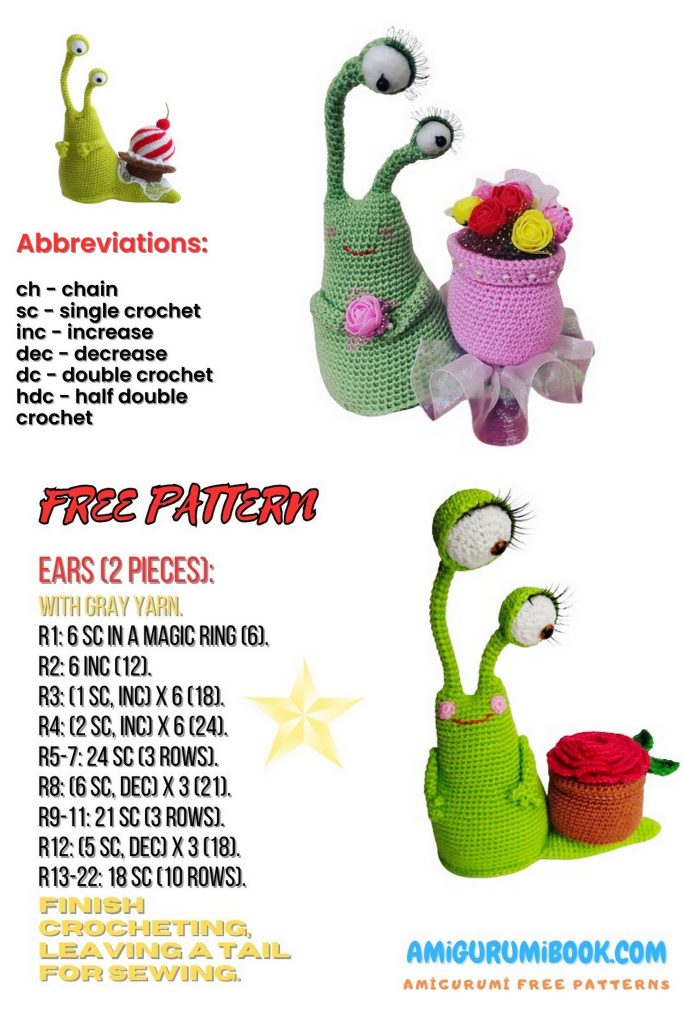

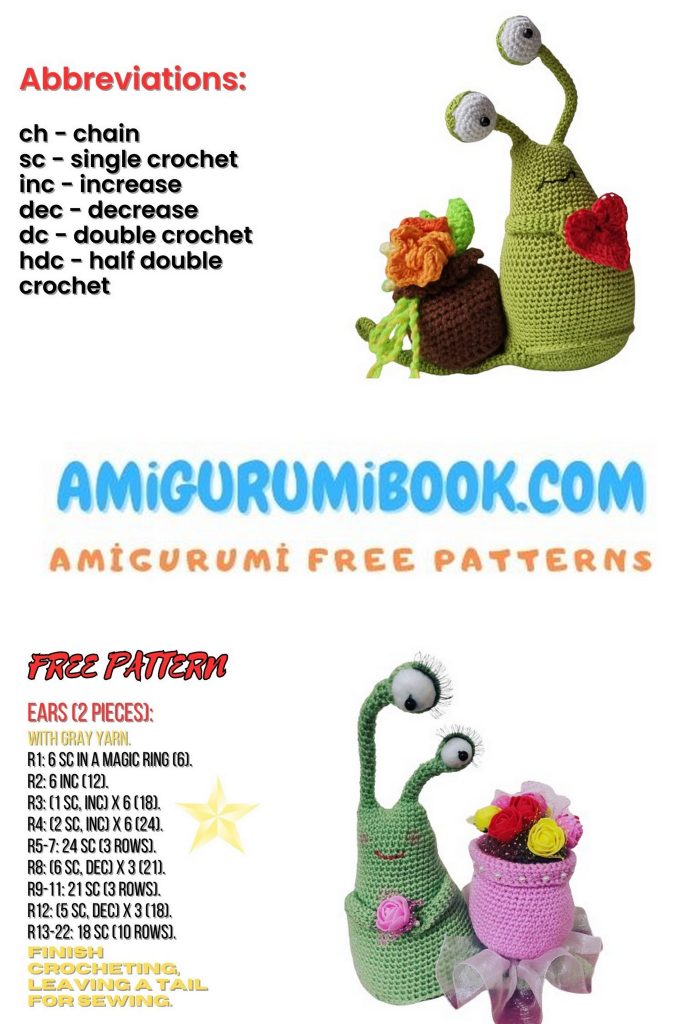
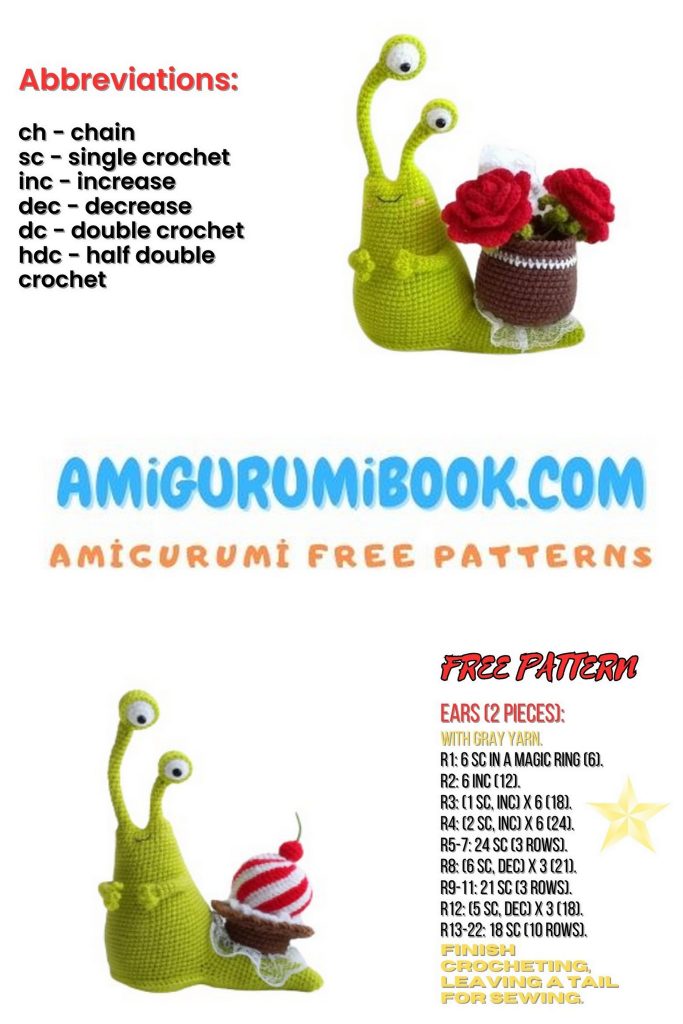
Now, use brown yarn to crochet the “soil” inside the flowerpot.
1st row: Attach the brown yarn to any of the back loops of the 24th row and crochet 48 sc in the round (48).
Evenly decrease this circle as follows:
2nd row: (6 sc, 1 sc2tog)*6 (42)
3rd row: (5 sc, 1 sc2tog)*6 (36)
4th row: (4 sc, 1 sc2tog)*6 (30)
Start stuffing the flowerpot.
5th row: (3 sc, 1 sc2tog)*6 (24)
6th row: (2 sc, 1 sc2tog)*6 (18)
7th row: (1 sc, 1 sc2tog)*6 (12)
8th row: 6 sc2tog (6)
Close the opening, secure the yarn, cut it, and hide it inside the flowerpot.
Next, take a piece of lace and sew it to have some pleats, using a simple running stitch in the lace’s color along its length, creating folds in the lace. Stitch the edges of the lace together to form a circle.
Neatly place the lace on the snail’s tail, folding it almost in half and evenly distributing the pleats along the tail. Secure the lace with pins on the tail and carefully sew it in place. Then, attach the flowerpot.
Sew on the remaining details: eyes, arms, and cheeks.
You can decorate the flowerpot with a small pattern or ornament using acrylic paint.
Now, take the small flowers and insert them into the flowerpot and the snail’s arms.
You can use black acrylic paint to add the eye pupils, or you can glue small black half-beads (or sew black beads) to the eyes. Position them so the snail is looking at the flowerpot.
And that’s how you create this beautiful springtime snail! Enjoy your craft project!